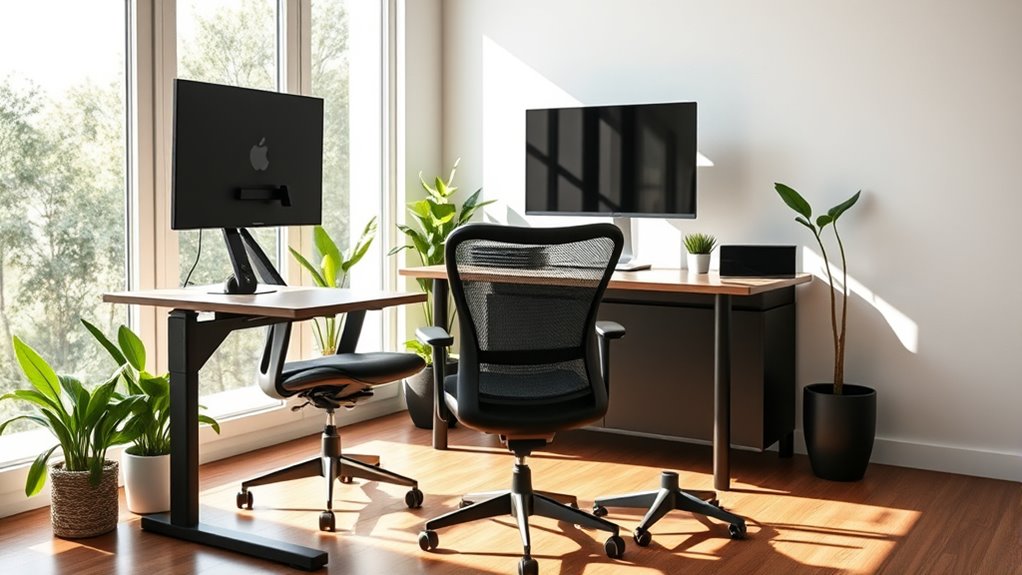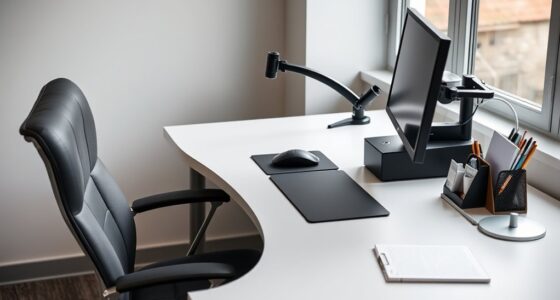To create an ergonomic home office, start by adjusting your desk and chair so your elbows form a 90-degree angle and your monitor is directly in front at eye level. Keep your feet flat and support your lower back with a lumbar pillow if needed. Use adjustable equipment and take regular movement breaks to stretch and reset your posture. Small changes can make a big difference—exploring these tips can help you set up a comfortable, healthy workspace.
Key Takeaways
- Ensure your desk and chair are adjustable to maintain proper height, support good posture, and promote comfort.
- Position your monitor at eye level directly in front, about an arm’s length away, to prevent neck strain.
- Keep your keyboard and mouse at a height that allows wrists to stay straight and elbows at a 90-degree angle.
- Incorporate movement breaks and stretching routines to improve circulation and reduce stiffness throughout the day.
- Personalize your workspace with ergonomic tools like adjustable stands, lumbar support, and footrests for optimal comfort.

Creating an ergonomic home office is essential for maintaining comfort and productivity, especially as remote work becomes more common. One of the most important aspects of this is your desk setup. Your desk should be at a height that allows your elbows to rest comfortably at a 90-degree angle when your hands are on your keyboard. You don’t want to be reaching up or down, as this can cause strain over time. The surface should be spacious enough to hold your monitor, keyboard, mouse, and any other essentials without feeling cluttered. Position your monitor directly in front of you, about an arm’s length away, with the top of the screen at or slightly below eye level. This setup helps you avoid neck strain and encourages proper posture correction.
When it comes to posture correction, the goal is to keep your spine aligned and supported throughout the day. Sit back fully into your chair, ensuring your lower back is supported by an adjustable lumbar pillow if needed. Keep your feet flat on the floor or on a footrest if your feet don’t reach comfortably. Your hips should be slightly higher than your knees, creating a gentle tilt that promotes good posture. Avoid crossing your legs, as this can lead to imbalance and discomfort. Keep your shoulders relaxed and your arms close to your body, with wrists straight while typing or using a mouse. Your screen should be directly in front of you to prevent twisting your neck or torso.
Adjust your chair height so that your thighs are parallel to the ground, and your arms rest comfortably on your desk or armrests. Use a keyboard tray if needed to keep your wrists in a neutral position. Regularly check your posture throughout the day; small adjustments can prevent chronic pain. Incorporate movement breaks to stretch and reset your posture—standing up, stretching your arms, or walking around helps reduce stiffness and improves circulation. Additionally, integrating AI-driven personalization in your ergonomic setup can help tailor your workspace to better fit your individual needs and reduce discomfort.
Investing in proper ergonomic equipment, like an adjustable chair, a monitor stand, or an ergonomic keyboard and mouse, can considerably enhance your desk setup. These tools make it easier to maintain posture correction and prevent discomfort. Remember, creating an ergonomic home office isn’t a one-time task; it’s an ongoing process of making small adjustments to support your body and boost productivity. Keep listening to your body’s signals, and don’t hesitate to tweak your setup as needed. By paying attention to your desk setup and posture correction, you’ll create a workspace that’s healthier, more comfortable, and conducive to sustained focus.
Frequently Asked Questions
How Can I Reduce Eye Strain in My Home Office?
To reduce eye strain in your home office, start by adjusting your screen positioning so it’s about arm’s length away and slightly below eye level. Use blue light filters or glasses to cut down on eye fatigue. Take regular breaks using the 20-20-20 rule—look at something 20 feet away for 20 seconds. These steps help protect your eyes and make your workspace more comfortable.
What Are the Best Ergonomic Accessories for Small Spaces?
In small spaces, you should choose ergonomic accessories that maximize functionality without clutter. Opt for compact furniture like a slim desk and an adjustable chair that fits your space. Incorporate multifunctional accessories, such as a monitor stand with storage or a foldable keyboard tray, to keep your workspace organized and comfortable. These choices help you maintain good posture while making the most of limited room, ensuring efficiency and comfort.
How Do I Adjust My Chair for Optimal Comfort?
Think of your chair as the foundation of your comfort castle. To adjust it, set the chair height so your feet rest flat on the floor and your knees are at a 90-degree angle. Make sure lumbar support fits snugly into your lower back’s natural curve. Fine-tune these settings until you feel balanced, supported, and ready to conquer your workday with ease and comfort.
What Lighting Options Prevent Fatigue During Long Work Hours?
To prevent fatigue during long work hours, you should prioritize good lighting. Use natural light whenever possible, as it reduces eye strain and boosts your mood. Supplement with adjustable lamps that allow you to customize brightness levels, minimizing glare and shadows. Position your lighting to evenly illuminate your workspace without causing reflections on screens. This combination keeps your eyes comfortable and helps maintain focus throughout your workday.
How Often Should I Take Breaks to Maintain Ergonomics?
While it’s tempting to power through long work hours, your body needs regular breaks. Aim to take a 5-10 minute break every hour, during which you can do stretching routines and posture adjustments. These small pauses prevent stiffness and discomfort, keeping your body aligned and alert. Consistent breaks not only support your ergonomics but also boost your productivity and focus throughout the day.
Conclusion
By now, you’re well-equipped to transform your home office into a comfortable, ergonomic space. Remember, creating an ideal work environment is like planting a garden—you need the right tools, patience, and care to see it flourish. Prioritize your comfort and health, and you’ll boost productivity and reduce strain. With these tips, your home office can become a sanctuary that supports you every day, making work feel less like a chore and more like a breeze.









